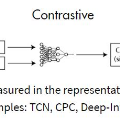Predicting the future trajectories of the traffic agents is a gordian technique in autonomous driving. However, trajectory prediction suffers from data imbalance in the prevalent datasets, and the tailed data is often more complicated and safety-critical. In this paper, we focus on dealing with the long-tail phenomenon in trajectory prediction. Previous methods dealing with long-tail data did not take into account the variety of motion patterns in the tailed data. In this paper, we put forward a future enhanced contrastive learning framework to recognize tail trajectory patterns and form a feature space with separate pattern clusters. Furthermore, a distribution aware hyper predictor is brought up to better utilize the shaped feature space. Our method is a model-agnostic framework and can be plugged into many well-known baselines. Experimental results show that our framework outperforms the state-of-the-art long-tail prediction method on tailed samples by 9.5% on ADE and 8.5% on FDE, while maintaining or slightly improving the averaged performance. Our method also surpasses many long-tail techniques on trajectory prediction task.
翻译:轨迹预测是自动驾驶领域的一个难点技术。然而,在现有数据集中,轨迹预测受到了数据不平衡的影响,而尾部数据通常更加复杂且涉及到更多安全问题。本文关注于解决轨迹预测中的长尾现象问题。以往的方法并没有充分考虑到尾部数据中的运动特征的多样性。因此,本文提出了一种未来增强的对比学习框架,以识别尾部轨迹模式并形成具有单独模式聚类的特征空间。此外,提出分布感知的超级预测模型,更好地利用已经形成的特征空间。我们的方法是一个模型无关的框架,可以嵌入许多知名的基线算法中。实验结果表明,我们的框架在尾部数据样本上比目前最先进的长尾预测方法性能提高了9.5%的ADE和8.5%的FDE,同时维持或略微提高了平均性能.我们的方法在轨迹预测任务上也优于许多长尾技术。


